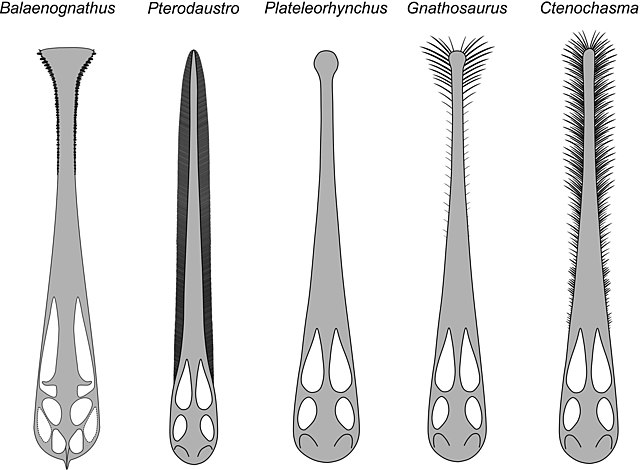Ctenochasmatidae
Family of ctenochasmatoid pterosaurs From Wikipedia, the free encyclopedia
Ctenochasmatidae is a group of pterosaurs within the suborder Pterodactyloidea. They are characterized by their distinctive teeth, which are thought to have been used for filter-feeding. Ctenochasmatids lived from the Late Jurassic to the Early Cretaceous periods.
| Ctenochasmatids | |
|---|---|
 | |
| Ctenochasma elegans specimen from Solnhofen | |
| Scientific classification | |
| Domain: | Eukaryota |
| Kingdom: | Animalia |
| Phylum: | Chordata |
| Order: | †Pterosauria |
| Suborder: | †Pterodactyloidea |
| Clade: | †Ctenochasmatoidea |
| Family: | †Ctenochasmatidae Nopsca, 1928[1] |
| Type species | |
| †Ctenochasma roemeri Meyer, 1852 | |
| Subgroups | |
| |

The earliest known ctenochasmatid remains date to the Late Jurassic Kimmeridgian age. Previously, a fossil jaw recovered from the Middle Jurassic Stonesfield Slate formation in the United Kingdom, was considered the oldest known. This specimen supposedly represented a member of the family Ctenochasmatidae,[4] though further examination suggested it actually belonged to a teleosaurid stem-crocodilian instead of a pterosaur.[5]
Classification
Below is cladogram following a topology recovered by Brian Andres, using the most recent iteration of his data set (Andres, 2021). Anders found that three subfamilies fall within the Ctenochasmatidae: Ctenochasmatinae, Gnathosaurinae and Moganopterinae, while also including several basal genera.[6]
| Ctenochasmatidae |
| ||||||||||||||||||||||||||||||
References
Wikiwand - on
Seamless Wikipedia browsing. On steroids.
